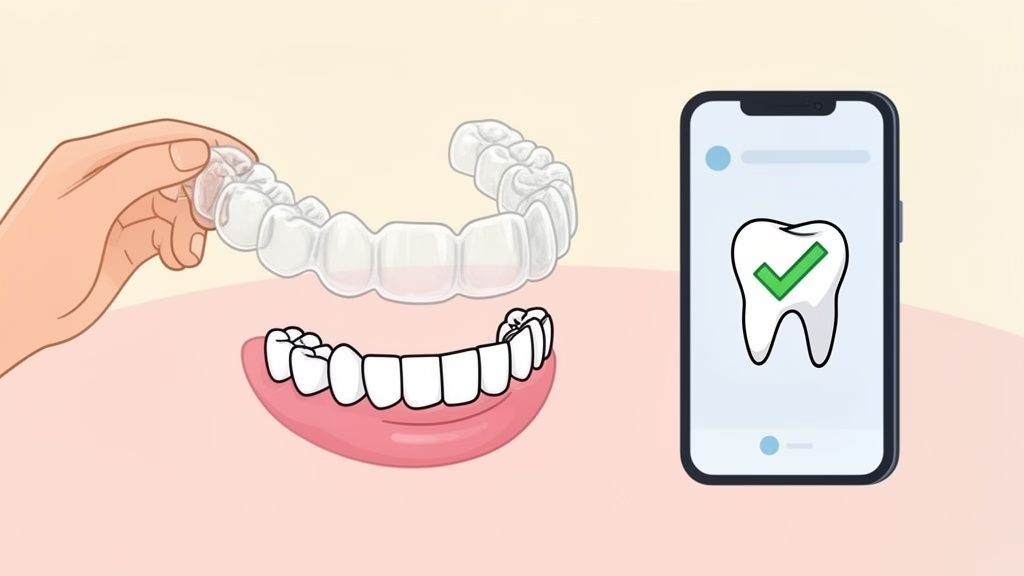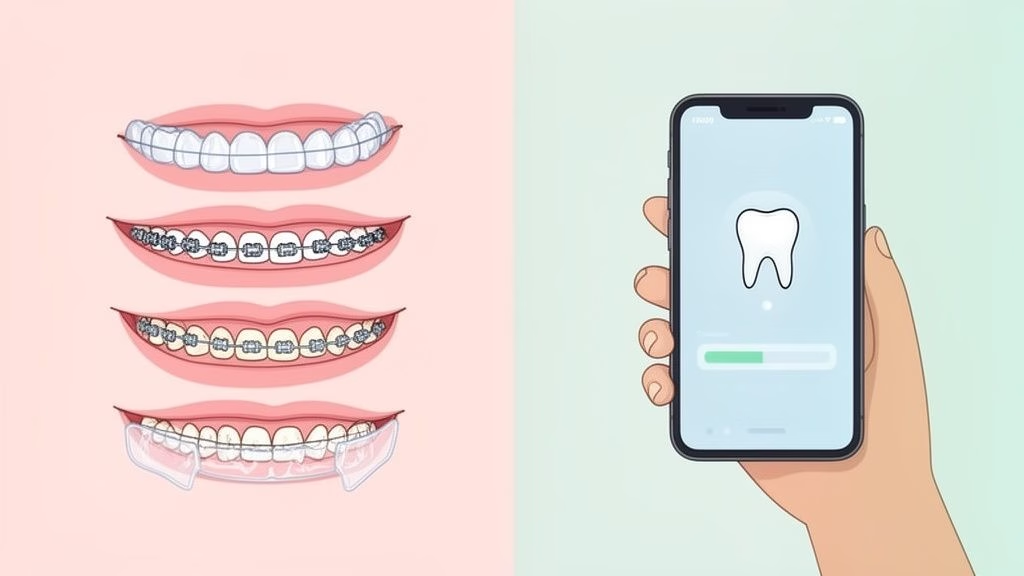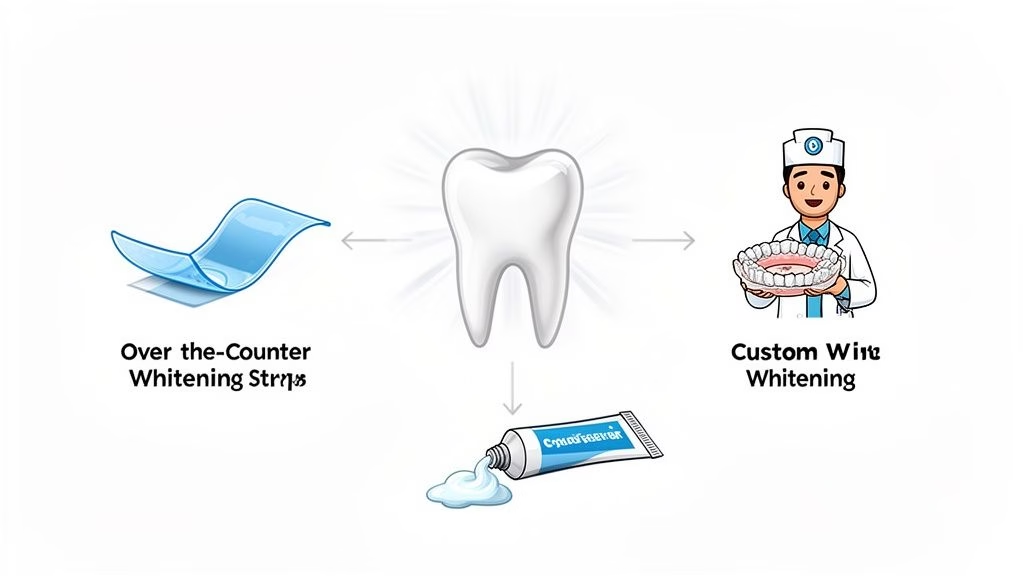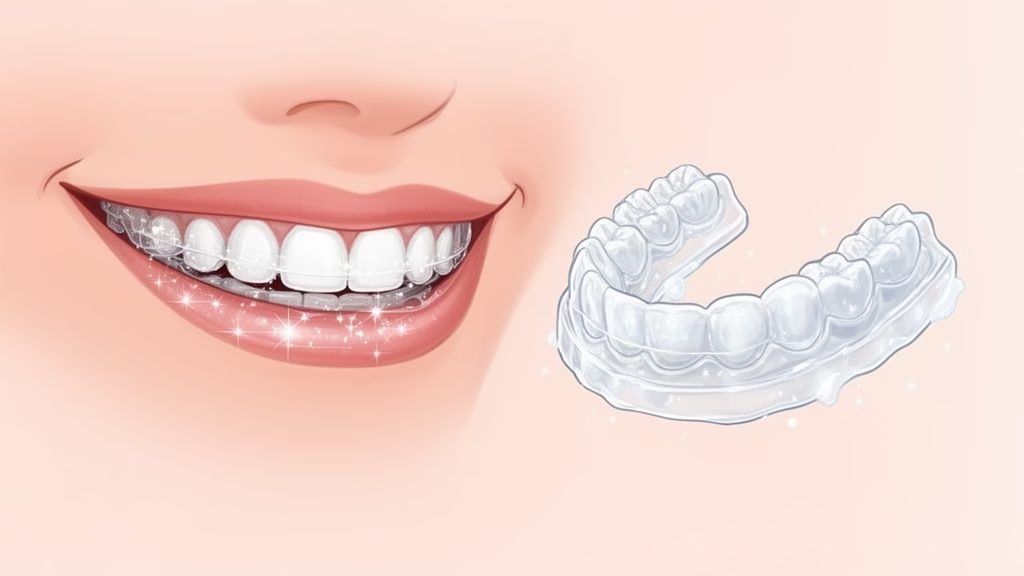Can Aligners Fix Overbite? A Step-By-Step Guide to Treatment Success
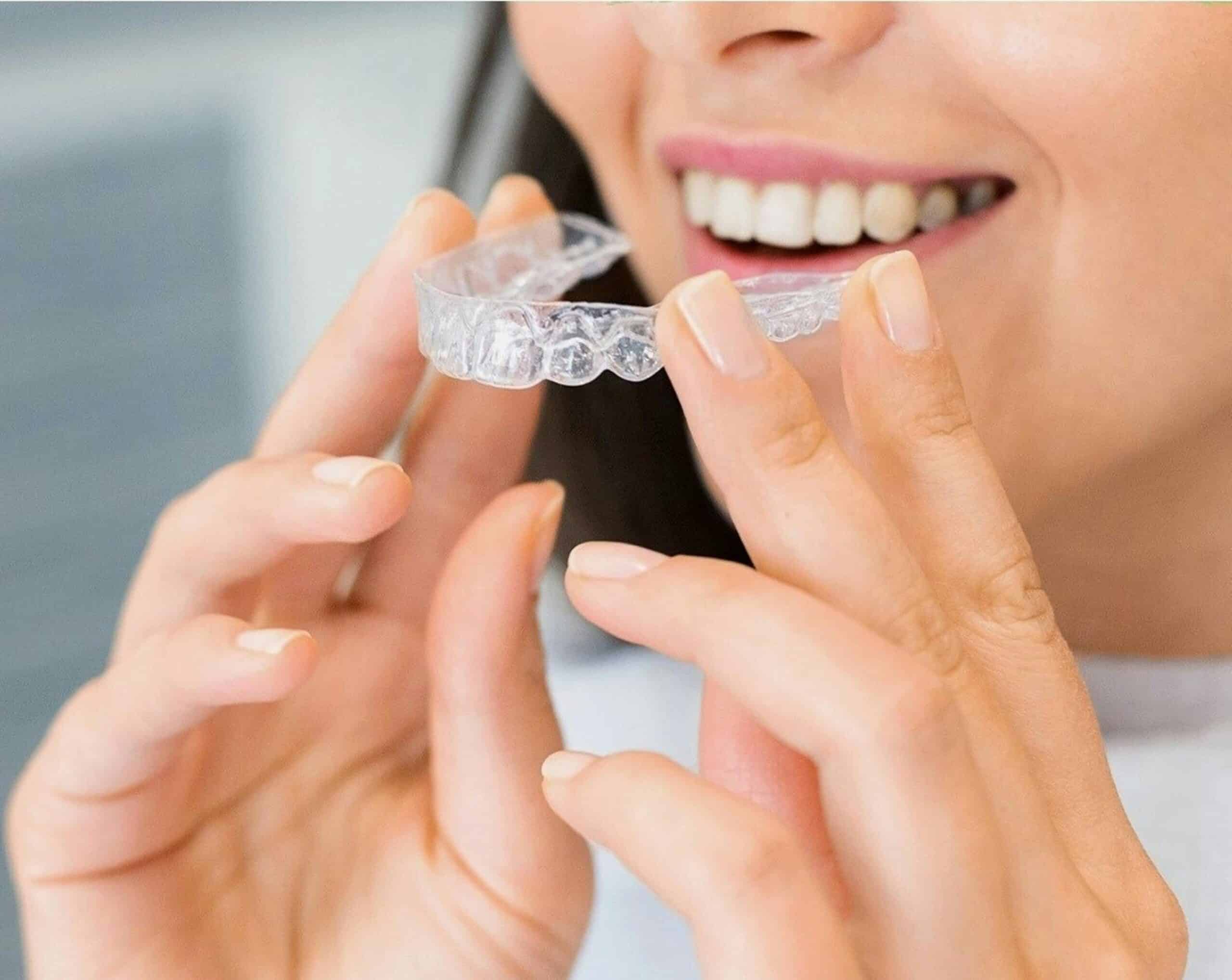
Understanding Your Overbite Journey with Clear Aligners

Yes, aligners can fix an overbite. This modern teeth-straightening method uses clear aligners instead of metal braces to gradually improve your bite alignment. The aligners work by slowly shifting your teeth into better positions over time.
How Aligners Work to Correct Overbites
Each patient receives custom aligners made with 3D imaging technology. You’ll wear each aligner for about two weeks, during which it applies gentle pressure to specific teeth. This controlled pressure prompts bone changes that allow teeth movement – similar to traditional braces but without visible metal components.
For patients whose upper front teeth significantly overlap their lower teeth, the aligners are engineered to shift the upper teeth back or move lower teeth forward as needed. The treatment can also fix related issues like gaps between teeth or crowding. This results in a more balanced bite overall.
Toothfairy’s Aligners’ success comes from its precise, gradual approach to teeth movement. While the aligners provide a more discreet option compared to metal braces, achieving the best results requires consistently wearing them as directed. The treatment’s effectiveness varies based on how complex your overbite is.
What Happens During Each Phase of Treatment?
Your treatment journey involves distinct phases focused on specific tooth movements. You’ll notice minor improvements early on as teeth begin shifting. The changes become more visible as you progress through your aligner series. This step-by-step process lets your mouth adjust comfortably to the new positions. Regular visits to your orthodontist allow them to check your progress and make any needed adjustments to keep your treatment on track. Being aware of these treatment phases helps you make good choices about your smile correction.
Real Results: Success Rates and Treatment Outcomes
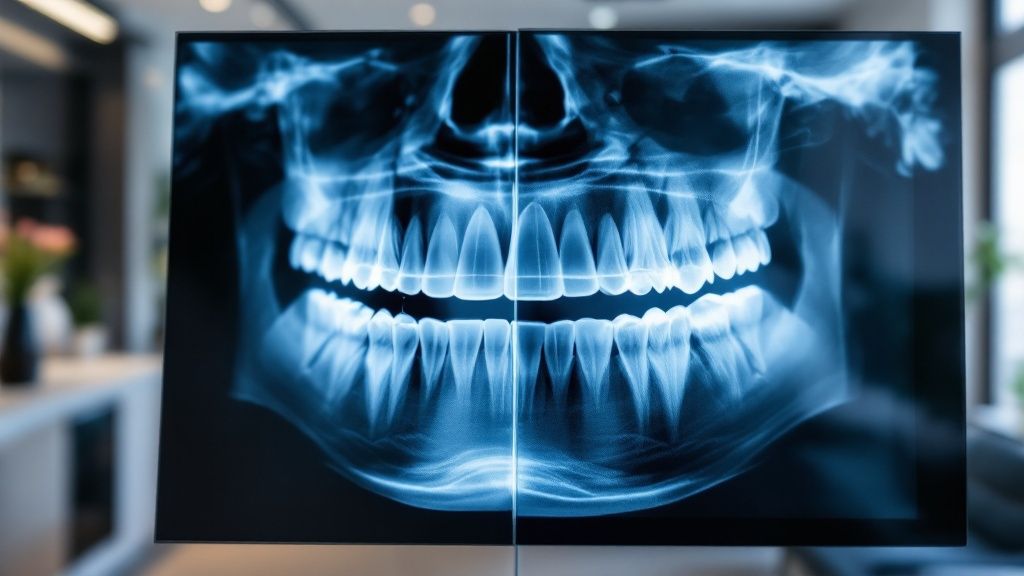
Many patients want to know about actual results and success rates when considering overbite correction. Let’s look at the real data and what drives positive treatment outcomes.
Success Rates for Overbites
The success of treatment depends heavily on patient commitment. Just like going to the gym, you’ll only see results if you wear your aligners for the recommended 20-22 hours daily. This consistent wear time is essential for moving teeth effectively.
The good news is that Aligners shows strong success rates. Studies indicate success rates between 90-96% for treating various orthodontic issues, including overbites. These high rates come from a combination of patient dedication and regular checkups with orthodontists. Keep in mind that more complex overbite cases may need additional treatments beyond aligners alone.
Factors Influencing Treatment Outcomes
Several key elements affect how well Treatment works:
- Your orthodontist’s expertise: More experienced providers can better plan treatments and handle any issues
- Your body’s response: Individual biology affects how quickly teeth move
- Starting condition: The initial severity of your overbite impacts treatment length and results
- Commitment to treatment: Following instructions precisely leads to better outcomes
Understanding Success in Your Context
Success looks different for each person. While statistics are helpful, your specific case is unique. Meeting with an orthodontist helps set realistic goals based on your particular needs. They can explain what results you can expect and create a plan that works for you. Getting actively involved in your treatment increases your chances of achieving the smile you want.
How Age Impacts Your Journey
Your age plays a major role in how effectively treatment can correct your overbite. Understanding how your body responds to orthodontic treatment at different life stages helps set realistic expectations for your treatment journey.
Teenage Years: A Prime Time for Aligners
The teenage years offer excellent conditions for orthodontic treatment. During adolescence, bones are more flexible and teeth are still developing, which allows for faster and more predictable tooth movement. Simple corrections like rotating teeth or closing gaps typically progress more quickly in teens compared to adults.
Treatment During Adulthood
While adult bones are denser and less malleable, aligners can still effectively fix overbites at any age. Orthodontists adapt treatment plans to work with adult bone structures. Many adults actually see great results because they tend to be more diligent about wearing their aligners consistently.
Recent research shows some interesting age-related differences. A 2023 study found that mandibular incisor intrusion (key for fixing deep overbites) was 18.2% more accurate in adolescents, achieving 63.5% accuracy compared to 45.3% in adults.
Different Ages Need Different Approaches
Orthodontists design treatment plans based on each patient’s age and unique biology. For teens, treatment takes advantage of natural growth phases. Adult treatment focuses on achieving optimal tooth movement within more stable bone structures.
Keys to Success at Any Age
Working in harmony with your body’s natural processes is essential for successful treatment. This means:
- Following your orthodontist’s instructions carefully
- Wearing aligners consistently for the recommended hours per day
- Keeping all scheduled checkup appointments
- Having realistic expectations based on your age
Understanding how age affects your treatment helps you approach treatment with the right mindset and commitment needed for the best results.
From Virtual Plan to Real Results: What to Actually Expect
Getting that dazzling smile with us starts with seeing amazing computer simulations of your future teeth. But it’s essential to know what actually happens between that first virtual preview and your final results. Real-world outcomes can differ from those early digital projections.
Bridging the Gap Between Virtual and Real
Your treatment begins with digital scans that create a 3D model of your teeth. While this technology helps map out your treatment path, remember that it’s a projection based on averages. Your actual results depend on unique factors like your bone structure, the type of bite correction needed, and your body’s response to treatment. For instance, if your teeth move more slowly than typical, your timeline and results might not perfectly match the simulation.
Factors Influencing Outcome Accuracy
Several key elements affect how well your results match the initial plan:
- Bite Complexity: Simple corrections often follow predictions more closely than complex cases with multiple alignment issues
- Following Instructions: You must wear aligners for 20-22 hours daily to stay on track
- Body Response: Each person’s teeth shift differently – some move easily while others need extra time
- Quality of Initial Records: Precise scans and measurements at the start are crucial for accurate planning
A 2024 research study examining 355 adult patients found interesting results about overbite correction. Planned reductions achieved only 8.69% of predicted changes in cases involving tooth extraction. However, when increasing overbite was the goal, results exceeded predictions by more than double. Read more details about this research here.
Setting Realistic Expectations and Tracking Your Progress
Success requires staying informed and maintaining regular communication with your orthodontist. Your check-up appointments serve two important purposes: monitoring your progress and discussing any differences between the planned and actual tooth movement. Your orthodontist can explain variations, adjust your treatment as needed, and help you understand what to expect as your smile improves.
Maximizing Your Treatment Success: Time and Compliance Strategies
Getting the best results from your overbite treatment comes down to two key elements: treatment duration and staying consistent with wearing your aligners. Understanding these factors will help you achieve your desired smile transformation.
How Long Does it Take to Fix an Overbite?
The time needed varies based on how severe your overbite is. For minor cases, treatment may take as little as 6 months. More complex overbites often need 18 months or more to fully correct. Just like any journey, the distance determines the time – a minor adjustment is like a short walk, while major corrections are more of a long trek.
Compliance: Your Key to Success
Aligners can effectively fix overbites, but only when used properly. You’ll need to wear your aligners for 20-22 hours each day, removing them just for meals, drinks and teeth cleaning. This consistent pressure on your teeth is what gradually moves them into the proper position. Like exercise, regular daily wear brings better results than sporadic use.
Strategies for Staying on Track
Here are some practical ways to stick with your treatment plan:
- Use Reminders: Set alarms on your phone to track wear time and aligner changes
- Build Daily Habits: Make aligner care part of your regular dental routine
- Keep Your Case Handy: Always bring your aligner case for safe storage while eating
- Stay Motivated: Keep a photo of your end goal to maintain commitment
Accelerating Your Progress Safely
While there’s no quick fix, proper compliance helps treatment stay on schedule. Wearing aligners consistently prevents delays, and regular checkups let your orthodontist monitor progress and adjust your plan if needed. Think of it like GPS navigation – your orthodontist can “recalculate” the best route to your perfect smile.
Troubleshooting Common Compliance Challenges
Even dedicated patients face occasional hurdles. Here are solutions to common issues:
- Discomfort: Speak with your orthodontist about adjustments or pain management tips
- Forgetting Aligners: Place multiple daily reminders and keep aligners visible
- Removal Difficulty: Use proper removal techniques or tools designed for aligners
By addressing these challenges early, you can stay focused on your treatment goals. Your commitment to following the plan directly impacts how quickly and effectively your overbite gets corrected.
Making the Smart Choice: Is it Right for Your Overbite?
Having an overbite can affect both your smile and oral health. Understanding if aligners is the right treatment option requires careful consideration of several key factors.
Key Considerations for Overbite Correction
Before starting treatment, you’ll want to evaluate these important aspects:
- Severity of Your Overbite: While it works well for mild to moderate cases, severe overbites may need traditional braces or combined treatment approaches
- Other Dental Issues: The presence of crowding, spacing, or other orthodontic concerns can affect your treatment plan
- Daily Commitment: Success requires wearing aligners for 20-22 hours each day. Consider if this fits your lifestyle
Aligners vs. Traditional Braces: A Cost and Lifestyle Comparison
Here’s how these two popular treatment options compare:
| Feature | Aligners | Traditional Braces |
|---|---|---|
| Appearance | Virtually invisible | Noticeable metal brackets and wires |
| Comfort | Generally more comfortable | Can cause irritation to cheeks and gums |
| Removability | Removable for eating and cleaning | Fixed in place |
| Cost | Often comparable to braces, but can vary | Typically less expensive than Aligners for complex cases |
| Treatment Duration | Similar to braces for many cases | Can be slightly faster for severe cases |
Evaluating Your Case: Questions to Ask Your Orthodontist
During your consultation, be sure to ask these key questions:
- Is my overbite suitable for treatment?
- What results can I realistically expect?
- How long will my treatment take?
- What are all the costs involved?
- What is your experience treating overbites?
Making Your Decision: A Practical Approach
Follow these steps to make an informed choice:
- Know your case: Understand how severe your overbite is
- Consider your daily routine: Can you commit to wearing aligners consistently?
- Get professional input: Schedule a thorough evaluation with an orthodontist
- Compare options: Look at all factors including cost, appearance, and treatment time
- Make your choice: Pick the option that best matches your needs and goals
Want to find out if we could work for your overbite? The Toothfairy app connects you with qualified dentists who can assess your case and recommend the best treatment plan. Book your consultation today to start your journey to a healthier smile!
Last updated on February 11, 2025

Dr. Deepak
ToothFairy Care Team.
Dr. Deepak
ToothFairy Care Team.
